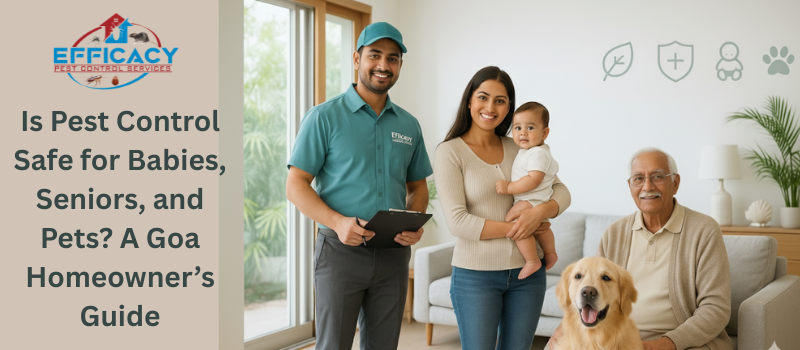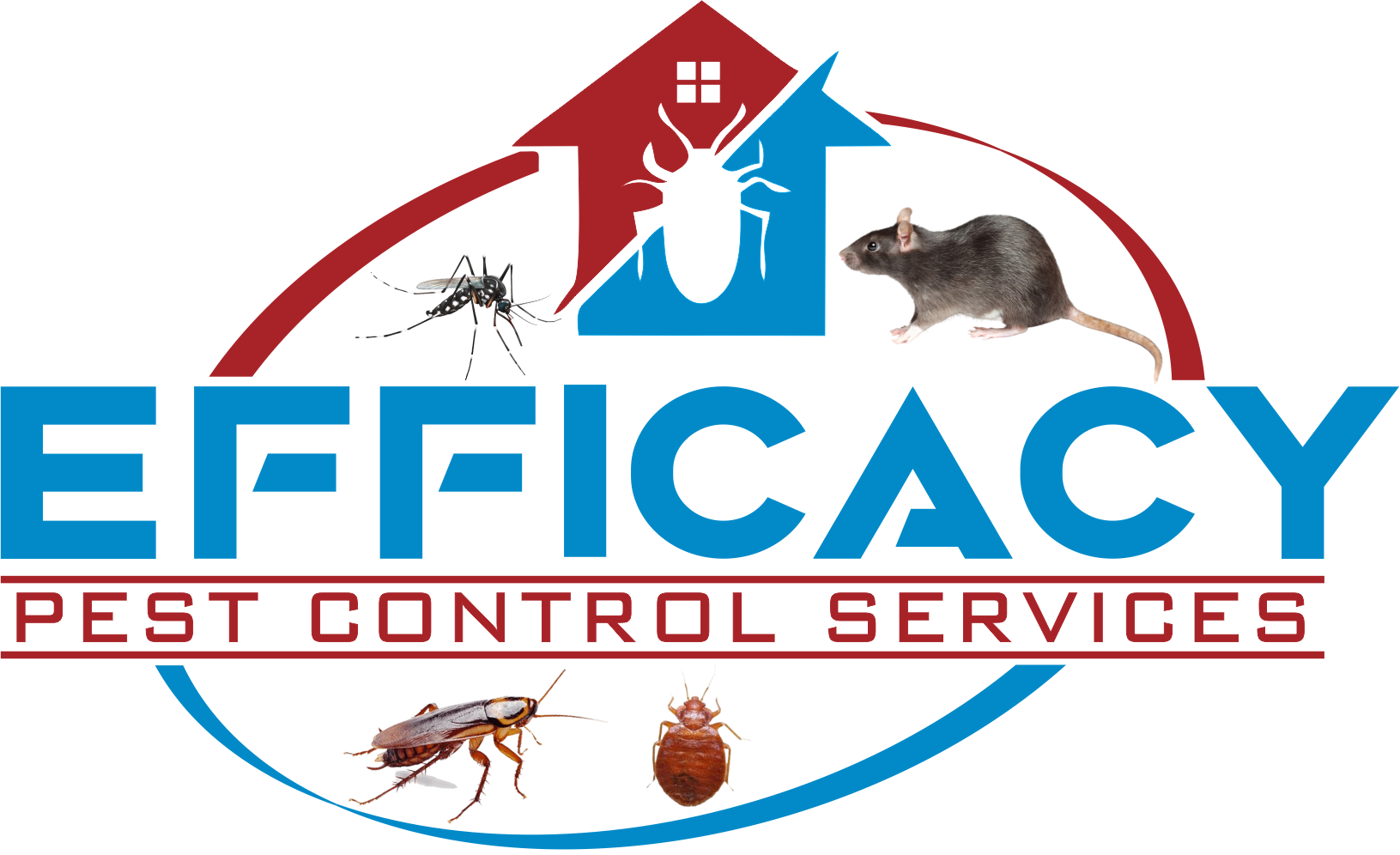
Is Pest Control Safe for Babies, Seniors, and Pets? A Goa Homeowner’s Guide
By Efficacy Pest Control (Goa) — +91 888-438-1111 | info@efficacypestcontrol.com | efficacypestcontrol.com
Goa’s warm, humid climate is paradise—for people and for ants, cockroaches, mosquitoes, termites, and rodents. If you’re a parent, caring for an elderly family member, or a pet parent, it’s natural to ask: “Will pest control harm my baby, old parents, or pets?” Short answer: When done professionally, with the right products and precautions, modern pest management is designed to be safe for vulnerable family members. The longer answer—and the exact steps we follow—are below.
First things first: how safety actually works
“Pesticides” is a broad word covering baits, gels, sprays, dusts, and repellents. Risk depends on what product is used, how much, where, and by whom. Professionals minimize exposure by:
- Choosing targeted formulations (e.g., gels and baits placed in cracks) over broad-area sprays whenever possible.
- Applying small, measured doses only where pests live or travel, not on open child/pet surfaces.
- Following label directions and re-entry intervals (the wait time before people and pets can use an area).
- In India, pest-control products must be registered with the Central Insecticides Board & Registration Committee (CIBRC); professional firms use only registered formulations and follow label precautions.
Babies and toddlers (and pregnant people)
Young children are more sensitive to exposures because of their size, fast metabolism, and frequent hand-to-mouth behavior. Medical groups advise reducing exposure and using safer methods first. What this means in practice:
- Prefer targeted applications (gels/baits in crevices, bait stations) over open spraying in nurseries and play areas.
- Remove/cover baby items (bottles, toys, feeding trays, bedding) before service; wash food-contact items afterward.
- Keep children and caregivers out of treated rooms until surfaces are dry and the area has been aired.
- During pregnancy, stick to the same precautions; if any treatment has strong odors or requires fogging, we schedule when the pregnant person can stay elsewhere for the label’s re-entry period.
Authoritative pediatric sources emphasize label compliance, careful storage, and minimizing residues—exactly what a good IPM (Integrated Pest Management) program does.
Seniors (elderly family members)
Older adults may have asthma, COPD, heart or kidney conditions, or heightened sensitivity to strong odors. Our approach:
- Ventilate well during and after service; use low-odor formulations and crack-and-crevice techniques.
- Seat or relocate the elder to a non-treated room or outdoor sit-out until the advised re-entry time.
- Wipe food-prep areas before use if they were covered but still inside a treated room.
Good ventilation and avoiding direct contact until dry are simple steps that reduce eye/airway irritation risks noted by indoor-air authorities.
Pets: dogs, cats, birds, fish, and small mammals
Pets are curious and close to the floor—exactly where bait stations and residues may be. We take extra care:
- Dogs & cats: Keep them out of treated rooms until dry and aired. Lift food/water bowls and toys beforehand; replace afterward. Rodent baits can be attractive to dogs—we only use tamper-resistant bait stations and place them out of access.
- Birds: Birds are sensitive to aerosols. We relocate them to a different, well-ventilated area during and after treatment until the label’s re-entry time.
- Fish/reptiles: Cover aquariums and switch off air pumps (they pull in airborne droplets) or move tanks to another room until it’s safe to return.
- Backyards & gardens: Allow pets back on treated lawns only after the product has dried and any granules have been watered-in per label.
If accidental ingestion/contact happens, call your vet promptly. Animal-care organizations regularly remind owners that fertilizers and some baits are tempting—and potentially hazardous—so storage and supervision matter.
Our “Safety-First” Process at Efficacy Pest Control (Goa)
We combine Integrated Pest Management (IPM) with CIBRC-registered products to protect your family and the environment:
- Inspection & identification – We find the source: entry points, breeding sites, food/water sources (common in Goa’s monsoon months).
- Non-chemical controls first – Sealing gaps, fixing moisture, sanitation advice, and trapping where suitable.
- Targeted chemistry – Preference for gels, baits, and precise crack-and-crevice applications in hard-to-reach harborages.
- Child & pet awareness – No open applications near cribs, play zones, feeding stations, or pet enclosures.
- Ventilation & re-entry guidance – We tell you exactly when it’s safe to re-enter/use treated rooms and what to wipe (if anything).
How you can prepare (simple checklist)
Before our visit
- Put away or cover baby bottles, pacifiers, toys, pet bowls, and bedding.
- Place fish tanks/bird cages in another room; turn off aquarium air pumps.
- Clear under-sink/behind-appliance areas so we can reach cockroach hotspots.
- Plan a short stroll or balcony time for kids, elders, and pets during treatment.
During treatment
- Keep family members in non-treated areas.
- Ask our technician about what was applied where, and the exact re-entry time.
After treatment
- Open windows/doors for cross-ventilation until dry.
- Wipe only food-prep surfaces before use; don’t wet-mop bait placements or we’ll lose effectiveness.
- Follow any follow-up schedule (especially for heavy infestations).
Common questions we hear
Why choosing a professional matters
- Measured dosing & placement reduce residues and keep treatments out of reach.
- Evidence-based choices: reputable sources stress child-proof storage, label adherence, and limiting exposure pathways; professional IPM follows those principles.
- Regulatory compliance: using CIBRC-registered products, with documentation on what was used where, helps you stay audit-ready for rentals, hotels, or home sales.
For context, indoor-air authorities list typical short-term symptoms from improper use (eye/throat irritation, headache, dizziness), which is exactly what professional controls aim to prevent by ventilation, limited application, and honoring re-entry times.
Bottom line
Yes—pest control can be safe for babies, seniors, and pets when you combine smart prevention, targeted applications, and strict label compliance. Most of the risk reduction comes from how and where products are used, not just which product. If you have a newborn, a pregnant family member, a senior with respiratory issues, or curious pets, tell us—we’ll tailor the treatment plan and schedule to your household.
Talk to a real person in Goa
Efficacy Pest Control
Phone: +91 888-438-1111
Email: info@efficacypestcontrol.com
Web: efficacypestcontrol.com
Call Email Visit WebsiteBook a safety-first inspection today—we’ll make pests go away while keeping your little ones, elders, and furry friends protected.


